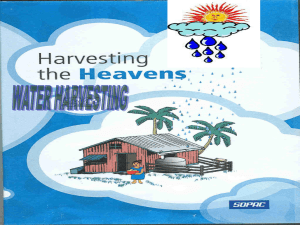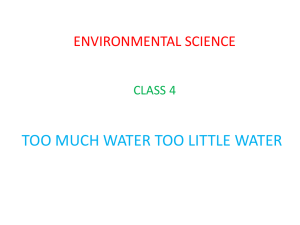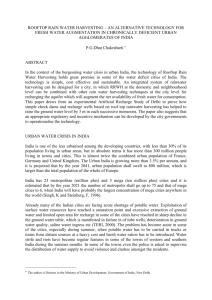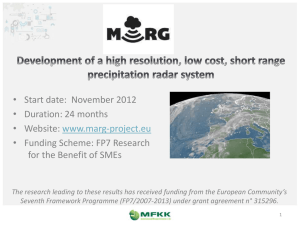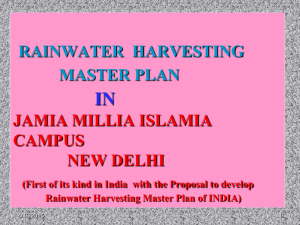Mr. Ajay Kumar Kanotra
advertisement
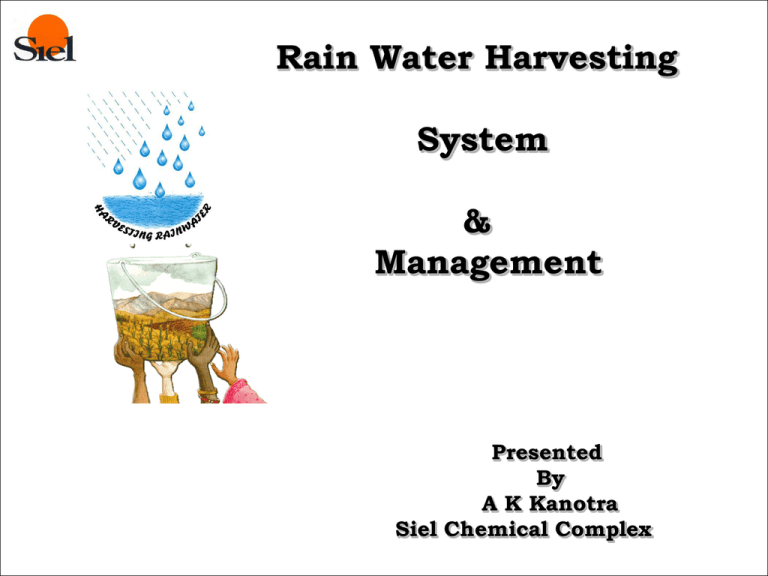
Rain Water Harvesting System & Management Presented By Presented By A K Kanotra Siel Chemical Complex Contents Introduction Concept and Technology of Rainwater Harvesting Average Rainfall of States in India Availability of Rainwater Through Roof Top Rainwater Harvesting Runoff Coefficients for Various Catchments Surfaces Rainwater Harvesting System Treatment Techniques Materials for Rainwater Tanks Rainwater Harvesting System at Siel Chemical Complex Introduction Every year, the water level in the state PUNJAB goes down by one meter. If this continues, the state will soon turn into a desert. So it is necessary to save every drop of water. “Every commercial building as well as big houses in the state must install Rain water harvesting system to save water” What is rain water harvesting ? • It is the activity of direct collection of rain water • Rain water can be stored for direct use or can be recharged into the ground water aquifer Rain Water in India • Total annual rainfall in India: 400 million hectaremeters (area x height) • India’s area: 329 million hectares • If evenly spread, average height: 1.28m • Actual distribution: – Highly skewed area-wise – The desert receives less than 200mm annually, while Cherrapunji receives 11,400mm – But almost every part of India receives at least 100mm annually • Key: even 100mm annual rainfall sufficient if harvested properly and where it falls But… . • Temporal distribution of rain in India also skewed • Rainfall in India seasonal (unlike Western countries) • Most of the country receives rainfall only for about 100 hours each year – Rough rule of thumb: #cm of rain = #hours rain received – E.g.: Jodhpur receives 40cm of rain in about 40 hours • Natural implication of such skew: – Most of the rain water lost due to runoffs – Unlike the west, very little water percolates into the ground – Hence, the importance of harvesting structures for local self-sufficiency Average Rainfall of States in India Average annual Sl.No. State Meteorological Divisions rainfall (mm) 1 Andaman and Nicobar Andaman and Nicobar Islands 2,967 2 Arunachal Pradesh Arunachal Pradesh 2,782 3 Assam Assam and Meghalaya 2,818 4 Meghalaya Assam and Meghalaya 2,818 5 Nagaland Nagaland, Manipur, Mizoram an Tripura 1,881 6 Manipur Nagaland, Manipur, Mizoram andTripura 1,881 7 Mizoram Nagaland, Manipur, Mizoram andTripura 1,881 8 Tripura Nagaland, Manipur, Mizoram andTripura 1,881 Sub-Himalayan West Bengal and Sikkim 2,739 9 West Bengal Gangetic West Bengal 1,439 10 Sikkim Sub-Himalayan West Bengal and Sikkim 2,739 Average annual Sl. No. 11 12 State Meteorological Divisions Orissa Bihar rainfall (mm) Orissa 1,489 Bihar Plateau 1,326 Bihar Plains 1,186 Uttar Pradesh 1,025 Plain of West Uttar Pradesh 896 Hills of West Uttar Pradesh 1,667 13 Uttar Pradesh 14 Haryana Haryana, Chandigarh and Delhi 617 15 Delhi Haryana, Chandigarh and Delhi 617 16 Chandigarh Haryana, Chandigarh and Delhi 617 17 Punjab Punjab 649 18 Himachal Pradesh Himachal Pradesh 1,251 19 Jammu Kashmir Jammu and Kashmir 1,011 20 Rajasthan and West Rajasthan 313 East Rajasthan 675 Average annual Sl. No. 21 State Madhya Pradesh Meteorological Divisions rainfall (mm) Madhya Pradesh 1,017 East Madhya Pradesh 1,338 Gujarat region 1,107 22 Gujarat Saurashtra and Kachchh 23 Goa Konkan and Goa 3,005 Konkan and Goa 3,005 24 Maharashtra 578 Madhya Maharashtra 901 Marathwada 882 Vidarbha Coastal Andhra Pradesh 1,034 1,094 Telengana 961 25 Andhra Pradesh Rayalaseema 680 26 Tamil Nadu Tamil Nadu and Pondicherry 998 27 Pondicherry Tamil Nadu and Pondicherry 998 Coastal Karnataka 3,456 North Interior Karnataka 731 28 Karnataka South Interior Karnataka 1,126 29 Kerala Kerala 3,055 30 Lakshadweep Lakshadweep 1,515 As per CENTRAL GROUND WATER AUTHORITY (Constituted under sub-section (3) of section 3 of the Environment (Protection) Act, 1986),NOC for Ground Water withdrawal will be considered for Industries/Infrastructure projects which are either NEW or under EXPANSION as per the criteria given below: Category Recycle/Reuse Withdrawal permitted (% of proposed recharge) Safe Mandatory recycling and reuse of water NOC is required for groundwater withdrawal if quantity of groundwater abstraction exceeds 100 m3/day. AR to groundwater to be adopted. However, Industries under B-VI have no exemption from obtaining NOC. Semi-critical Major and Medium industries shall recycle and reuse at least 50% of the waste water Withdrawal may be permitted subject to undertaking of recharge** measures. The withdrawal should not exceed 200% of the recharged quantity. Critical Major and Medium industries should fully recycle and reuse the waste water Withdrawal may be permitted subject to undertaking of recharge** measures. The withdrawal should not exceed 100% of the recharged quantity. Overexploite d Full utilization of recycled water and reuse of water should be mandatory Withdrawal may be permitted subject to undertaking of recharge** measures. The withdrawal should not exceed 50% of the recharged quantity. Why Rain water harvesting • To conserve & augment the storage of ground water • To reduce water table depletion • To improve the quality of ground water • To arrest sea water intrusion in coastal areas • To avoid flood & water stagnation in urban areas 4 Concept and Technology of Rainwater Harvesting Rainwater is a free source of nearly pure water and rainwater harvesting refers to collection and storage of rainwater and other activities aimed at harvesting surface and ground water. It also includes prevention of losses through evaporation and seepage and all other hydrological and engineering interventions, aimed at conservation and efficient utilization of the limited water. In general, water harvestings the activity of direct collection of rainwater. The rainwater collected can be stored for direct use or can be recharged into the ground water. There are two main techniques of rain water harvestings. • Storage of rainwater on surface for future use. • Recharge to ground water. RAIN WATER HARVESTING Rain Rooftop Water Roof Top Filtration or Storage Recharge to ground water Technology of Rainwater Harvesting Example of Small level Rain Water harvesting in villages in India Availability of Rainwater Through Roof Top Rainwater Harvesting Water available from Roof = Annual rainfall (in mm) x roof area (in sq. m) x co-efficient of run off for roof Suppose the system has to be designed for meeting drinking water requirement of a 5-member family living in a building with a rooftop area of 100 sq.m. Average annual rainfall in the region is 600 mm. Daily drinking water requirement per person (drinking and cooking) is 10 liters. We shall first calculate the maximum amount of rainfall that can be harvested from the rooftop .Following details are available: Area of the catchments (A) = 100 sq.m. Average annual rainfall (R) = 600 mm (0.6 m) Runoff coefficient (C) = 0.85 Annual water harvesting potential from 100 sq.m. roof =AxRxC = 100 x 0.6 x 0.85 = 51 cu.m. (51,000 ltr) The tank capacity has to be designed for the dry period, i.e., the period between the two consecutive rainy seasons. With the rainy season extending over four months, the dry season is of 245 days. Particular care must be taken to ensure that potable water is not contaminated by the collected rainwater. Drinking water requirement for the family (dry season) = 245 x 5 x 10 = 12,250 ltr. As a safety factor, the tank should be built 20 per cent larger than required, i.e., 14,700 ltr. This tank can meet the basic drinking water requirement of a 5-member family for the dry period. co-efficient of run off GI sheet 0.90 Asbestos 0.80 Tiled 0.75 Plaster on bricks/ Concrete 0.70 All rainwater-harvesting systems comprise six basic components irrespective of the size of the system. 1. Catchments area/roof: The surface upon which the rain falls; the roof has to be appropriately sloped preferably towards the direction of storage and recharge. 2. Gutters and downspouts: The transport channels from catchments surface to storage; these have to be designed depending on site, rainfall characteristics and roof characteristics. 3. Leaf screens and roof washers: The systems that remove contaminants and debris; a first rain separator has to be put in place to divert and manage the first 2.5 mm of rain. 4. Storage tanks: Sumps, tanks etc. where collected rain-water is safely stored or recharging the ground water through open wells, bore wells or percolation pits etc. 5. Conveying: The delivery system for the treated rainwater, either by gravity or pump; 6. Water treatment: Filters to remove solids and organic material and equipment, and additives to settle, filter, and disinfect. Rain Water Distribution & Management Treatment Techniques Screening Methods Strainers and Leaf Screens Location Gutters and Leaders Results Prevent leaves and other debris from Settling Sedimentation Within Tank Settles particulate matter Filtering In-line/Multi-Cartridge Activated Carbon Reverse Osmosis Mixed Media Slow Sand After Pump At Tap At Tap Separate Tank Separate Tank Sieves sediment Removes chlorine Removes contaminants Traps particulate matter Traps particulate matter Disinfecting Boiling/Distilling Chemical Treatments Ultraviolet Light Ozonation Before use Within tank After the activated carbon filter Before Tap Kills Kills Kills Kills microorganisms microorganisms microorganisms microorganisms Materials for Rainwater Tanks Plastic: Fiberglass: Fiberglass tanks are lightweight, reasonably priced, and long lasting, making them one of the most popular tanks in contemporary installations. As with the polyethylene and galvanized tanks, fiberglass tanks are commercially available and easy to transport. They are available in a wide range of sizes and can be specified for potable water. Fiberglass tanks should be coated or constructed to prevent penetration of sunlight into the tank. Plastic Liner: Plastic liners are sometimes used to line concrete tanks or tanks that have developed leaks. These liners can also be used to line lowcost, temporary collection tanks constructed of materials such as plywood. Plastic liners that are specified for potable use are commercially available. Polyethylene: In many countries these tanks are commercially available in a variety of sizes, shapes, and colors, and can be constructed for above or below ground installations. Polyethylene tanks are gaining popularity due to their relatively low cost and because they one slightly more durable than fiberglass with comparable life expectancy. Their light weight makes them easy to transport and relocate Metal: Galvanized steel tanks are also used. These are commercially available and reasonably priced and are quite popular. They are noted for their strength, yet are relatively lightweight and easy to move. Corrosion can be a problem if exposed to acidic conditions; some suppliers provide an inside liner to guard against this problem. In addition, high and low pH water conditions can result in the release of zinc. Rainwater Harvesting System at Siel Chemical Complex Rainwater Harvesting System at Siel Chemical Complex SIEL Chemical Complex is a Caustic Soda production plant located at Rajpura. It has ISO 14000 certification and the organization is very much concerned to improve the Environmental standards within and outside the premises of company. To improve the Ground water level in the surrounding areas, organization is trying to implement the Rain Water Harvesting within the premises. In SCC, we are having 02 nos units of rain water harvesting . The first unit of rain water harvesting was installed and taken in operation w.e.f. July 20,2007. It is estimated that around 500m3 of water will be charged into the ground in a year, with an average rainfall of 82 cms . Rainwater Harvesting System at Siel Chemical Complex Here we are considering the only Rooftop of A & PO building, Security block building and HR and Administrative block building for rainwater harvesting. Rooftop area of A&PO building = 304 sq. m. Rooftop area of security block building = 192 sq. m. Rooftop area of HR and administrative block building = 662 sq. m. Total Rooftop Area = 1158sq.m. Average Rainfall in this region = 82.23 cm. = .82 m. Assuming that 60% of total rainfall is effectively harvested. Volume of water harvested = 1158 X .82 X .6 cu. m. = 569.736 cu. m. = 569736 ltr. So we can save 569 m3. of water annually from above said building THANK YOU
